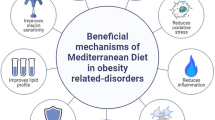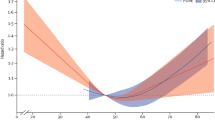Abstract
Background
Obesity is considered a risk factor for other chronic diseases, and diets rich in lipids can cause alterations in the intestinal functions.
Aim
The aim of this study was to investigate the effects of a high-fat diet (HFD) on the myenteric plexus of the large intestine in mice.
Methods
Swiss mice were distributed into four groups: Control animals fed standard chow for 8 and 17 weeks (C8 and C17 groups) and hyperlipidic animals fed HFD for 8 and 17 weeks (Ob8 and Ob17 groups). Immunofluorescence was performed in the large intestine for the morphologic and quantitative analysis of neuronal populations.
Results
Animals in the Ob17 group exhibited increased body weight and visceral fat gain compared with the C17 group. The intestinal area was also reduced in the two Ob groups. In the proximal colon, the Ob17 group exhibited 16.1 % reduction of the general neuronal density and 33 % reduction of the VIP-immunoreactive (IR) subpopulation. The general neuronal density in the distal colon was reduced by 45 % in the Ob17 group, and the nNOS-IR density was reduced by 35 %. The morphometry of neuronal cell bodies in the Ob17 group exhibited a reduction of the neuronal area of all of the neuronal populations studied in the proximal colon, with a reduction of the subpopulations of nNOS-IR and VIP-IR neurons in the distal colon.
Conclusions
The HFD caused neuronal loss in the myenteric plexus, and nitrergic neurons were more resilient. The changes were more pronounced in the distal colon after 17 weeks.




Similar content being viewed by others
References
Fonseca-Alaniz MH, Takada J, Alonso-Vale MI, Lima FB. Adipose tissue as an endocrine organ: from theory to practice. J Pediatr (Rio J). 2007;83:S192–S203.
Hotamisligil GS. Inflammation and metabolic disorders. Nature. 2006;444:860–867.
Hariri N, Thibault L. High-fat diet-induced obesity in animal models. Nutr Res Rev. 2010;23:270–299.
Rasouli N, Kern PA. Adipocytokines and the metabolic complications of obesity. J Clin Endocrinol Metab. 2008;93:S64–S73.
Li H, Lelliott C, Håkansson P, et al. Intestinal, adipose, and liver inflammation in diet-induced obese mice. Metabolism. 2008;57:1704–1710.
Arçari DP, Bartchewsky W, dos Santos TW, et al. Antiobesity effects of yerba maté extract (ilex paraguariensis) in high-fat diet-induced obese mice. Obesity (Silver Spring). 2009;17:2127–2133.
Lam YY, Ha CW, Campbell CR, et al. Increased gut permeability and microbiota change associate with mesenteric fat inflammation and metabolic dysfunction in diet-induced obese mice. PLoS One. 2012;7:e34233.
Lakhan SE, Kirchgessner A. Gut microbiota and sirtuins in obesity-related inflammation and bowel dysfunction. J Transl Med. 2011;9:202.
Liu T, Hougen H, Vollmer AC, Hiebert SM. Gut bacteria profiles of mus musculus at the phylum and family levels are influenced by saturation of dietary fatty acids. Anaerobe. 2012;18:331–337.
Serino M, Luche E, Gres S, et al. Metabolic adaptation to a high-fat diet is associated with a change in the gut microbiota. Gut. 2012;61:543–553.
Cani PD, Bibiloni R, Knauf C, et al. Changes in gut microbiota control metabolic endotoxemia-induced inflammation in high-fat diet-induced obesity and diabetes in mice. Diabetes. 2008;57:1470–1481.
Nezami BG, Mwangi SM, Srinivasan S. Delayed intestinal motility and reduced enteric neuronal survival in hyperlipidemia: role of autophagy and er stress. Gastroenterology. 2012;142:S272.
Furness JB. The enteric nervous system. 1st ed. Victoria: Blackwell; 2006.
Drengk AC, Kajiwara JK, Garcia SB, et al. Immunolocalisation of myosin-v in the enteric nervous system of the rat. J Auton Nerv Syst. 2000;78:109–112.
Buttow NC, Zucoloto S, Espreafico EM, Gama P, Alvares EP. Substance p enhances neuronal area and epithelial cell proliferation after colon denervation in rats. Dig Dis Sci. 2003;48:2069–2076.
Phillips RJ, Powley TL. Innervation of the gastrointestinal tract: patterns of aging. Auton Neurosci. 2007;136:1–19.
Van Geldre LA, Lefebvre RA. Interaction of no and vip in gastrointestinal smooth muscle relaxation. Curr Pharm Des. 2004;10:2483–2497.
Mushref MA, Srinivasan S. Effect of high fat-diet and obesity on gastrointestinal motility. Ann Transl Med. 2013;1:14.
Reeves PG. Components of the ain-93 diets as improvements in the ain-76a diet. J Nutr. 1997;127:838S–841S.
Schoffen JP, Soares A, de Freitas P, Buttow NC, Natali MR. Effects of a hypoproteic diet on myosin-v immunostained myenteric neurons and the proximal colon wall of aging rats. Auton Neurosci. 2005;122:77–83.
Souza ID, Ribeiro JS, Bersani-Amado CA, Zanoni JN. Analysis of myosin-v immunoreactive myenteric neurons from arthritic rats. Arq Gastroenterol. 2011;48:205–210.
Libinaki R, Heffernan M, Jiang WJ, et al. Effects of genetic and diet-induced obesity on lipid metabolism. IUBMB Life. 1999;48:109–113.
Ghanayem BI, Bai R, Kissling GE, Travlos G, Hoffler U. Diet-induced obesity in male mice is associated with reduced fertility and potentiation of acrylamide-induced reproductive toxicity. Biol Reprod. 2010;82:96–104.
Huffman DM, Barzilai N. Role of visceral adipose tissue in aging. Biochim Biophys Acta. 2009;1790:1117–1123.
Voss U, Sand E, Olde B, Ekblad E. Enteric neuropathy can be induced by high fat diet in vivo and palmitic acid exposure in vitro. PLoS One. 2013;8:e81413.
Cani PD, Neyrinck AM, Fava F, et al. Selective increases of bifidobacteria in gut microflora improve high-fat-diet-induced diabetes in mice through a mechanism associated with endotoxaemia. Diabetologia. 2007;50:2374–2383.
Tehrani AB, Nezami BG, Gewirtz A, Srinivasan S. Obesity and its associated disease: a role for microbiota? Neurogastroenterol Motil. 2012;24:305–311.
Nezami BG, Mwangi SM, Lee JE, et al. Microrna 375 mediates palmitate-induced enteric neuronal damage and high-fat diet-induced delayed intestinal transit in mice. Gastroenterology. 2014;146:473.e473–483.e473.
Yu LC, Wang JT, Wei SC, Ni YH. Host-microbial interactions and regulation of intestinal epithelial barrier function: from physiology to pathology. World J Gastrointest Pathophysiol. 2012;3:27–43.
Arciszewski MB, Sand E, Ekblad E. Vasoactive intestinal peptide rescues cultured rat myenteric neurons from lipopolysaccharide induced cell death. Regul Pept. 2008;146:218–223.
Wang N, Wang H, Yao H, et al. Expression and activity of the tlr4/nf-κb signaling pathway in mouse intestine following administration of a short-term high-fat diet. Exp Ther Med. 2013;6:635–640.
Ye D, Li FY, Lam KS, et al. Toll-like receptor-4 mediates obesity-induced non-alcoholic steatohepatitis through activation of x-box binding protein-1 in mice. Gut. 2012;61:1058–1067.
Shotton HR, Lincoln J. Diabetes only affects nitric oxide synthase-containing myenteric neurons that do not contain heme oxygenase 2. Brain Res. 2006;1068:248–256.
Zakhary R, Gaine SP, Dinerman JL, Ruat M, Flavahan NA, Snyder SH. Heme oxygenase 2: endothelial and neuronal localization and role in endothelium-dependent relaxation. Proc Natl Acad Sci U S A. 1996;93:795–798.
Stenkamp-Strahm CM, Kappmeyer AJ, Schmalz JT, Gericke M, Balemba O. High-fat diet ingestion correlates with neuropathy in the duodenum myenteric plexus of obese mice with symptoms of type 2 diabetes. Cell Tissue Res. 2013;354:381–394.
Acknowledgments
The authors thank the Post-graduation Program in Cell Biology of the State University of Maringá and National Council of Scientific and Technological Development (CNPq) for financial support.
Conflict of interest
None.
Author information
Authors and Affiliations
Corresponding author
Rights and permissions
About this article
Cite this article
Beraldi, E.J., Soares, A., Borges, S.C. et al. High-Fat Diet Promotes Neuronal Loss in the Myenteric Plexus of the Large Intestine in Mice. Dig Dis Sci 60, 841–849 (2015). https://doi.org/10.1007/s10620-014-3402-1
Received:
Accepted:
Published:
Issue Date:
DOI: https://doi.org/10.1007/s10620-014-3402-1




